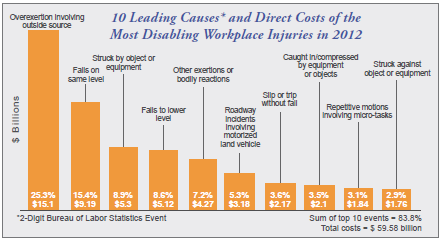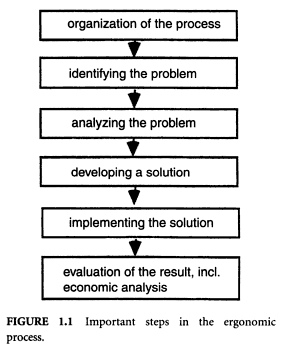By: Tim Foulks
July 2015
Ergonomics, the process of designing systems, processes, or products with an emphasis on the interaction between the system and the human, is widely recognized as a proactive and effective method to reduce musculoskeletal disorders (MSDs). Ergonomic techniques typically focus on an assessment process followed by interventions that can reduce the potential for musculoskeletal strains and sprains. While this methodology is shown to be effective and widely used within manufacturing and warehouse settings, construction ergonomics is very much in its infancy. Although an emerging technique for construction, there is an immediate need to develop and implement this process.

Aside from transportation, the construction industry sees the greatest number of MSDs with regards to the lower back and the upper extremities. In fact, the Workplace Safety Index, presented by Liberty Mutual in 2014, indicates that the leading cause of workplace injury was overexertion. Overexertions include injuries that result from lifting, pushing, pulling, holding, carrying, or throwing. This injury category accounted for 25.3% of all workplace injuries and accounted for $15.1 billion dollars in direct costs to employers. The potential for ergonomics to decrease costs and maintain a physically capable workforce is substantial and should be considered as a possible business function.
Developing an Ergonomic Process:
The springboard to implement controls from an ergonomic perspective is to develop a protocol for guidance throughout the entire ergonomic process. The protocol should be specific with regards to the communication of potential opportunities and areas where improvement can be facilitated. Within construction, opportunities for improvement can most likely be determined by a detailed injury log with the specific tasks outlined during which time injury occurred. This type of data analysis can show trends where injuries are most often to occur and present immediate areas to incorporate some type of control. Although a reactive method in the early stages, an ergonomics program can quickly become proactive by adhering to an implemented protocol and involving employees in the ergonomic process.

Employees who perform the work know the areas that are the most physically demanding, difficult, and those that contribute to musculoskeletal discomfort. This knowledge is paramount in determining where to focus ergonomic analysis and begin implementing controls to remove potential hazards.
The construction industry presents another barrier as the environment in construction is constantly changing and adapting to the needs of the project. For this reason, maintaining a detailed log of successful ergonomic controls used previously can help the employer implement similar controls at future projects or when the nature of the work changes. For example, if injuries were found to be common when handling large, awkward material, such as drywall sheets, implementing a drywall transport cart may have mitigated injuries on a previous construction project. Maintaining a detailed log of ergonomic successes can allow you to immediately implement the solution at future projects, thereby eliminating the exposure prior to an employee experiencing a similar injury. Moreover, the ergonomic log may present insight into what has not worked in the past allowing for exploration into new, more effective solutions.
After the ergonomic protocol has been established, it should remain a critical business function to maximize the cost savings from the overall reduction of workplace injuries. The ergonomic protocol should be revisited and involved in the planning stages of future projects.
Ergonomic Controls:
Ergonomic controls have three main categories: engineering controls, wherein the risk is engineered out of the environment (through design, tools, hoists, or other equipment changes), administrative controls, such as changes to policies or procedures (such as lifting techniques, pre-shift stretching, or job rotation), and personal protective equipment (PPE). Similar to controls in the safety industry, the desired control that typically shows the greatest result is an engineering control.

There also tends to be a varying level of complexity in the type of control implemented. Some controls will be inherently simple, such as implementing a stretching program or providing modified hand-tools, while others will be complex and require additional planning. The complexity of a control should not be used as a deterrent, but will require varying degrees of planning and support.
Additionally, the overall cost to implement ergonomic controls needs to be a factor involved in budgeting and planning. The ergonomic program will see the greatest return on investment when implementing controls that are lower-cost with higher effectiveness. For example, purchasing jack-hammers that are designed with reduced-vibration may be more costly than, and, only marginally more effective than introducing anti-vibration gloves that meet the ISO 10819 standard. In this example, introducing anti-vibration gloves may be the desired solution and result in a faster return on investment for the employer.
For any control implemented, there may be a training component necessary to ensure that the workforce is utilizing the control properly and effectively reducing the risk. Training workers will show your commitment to injury prevention and ensure the tool is being used as intended by the manufacturer’s specifications.
There are undoubtedly an incredible number of controls available to minimize muscular strains and sprains in the construction industry, and many that can be developed through trial and error. Fortunately for employers, the Washington State Department of Labor and Industries has developed an “Ideas Bank” that can help your company find solutions to mitigate high-risk areas.
The potential for ergonomic solutions to mitigate injury costs is obvious and may help alleviate direct and indirect costs of injuries as well as a company’s overall Experience Modification Rate (EMR). Ergonomics requires a commitment to the process that will be well worth the time when an overall decrease to musculoskeletal injuries comes to light.
Related Topics: Ergonomics, Construction Safety, Safety Articles, Monthly Safety Topics